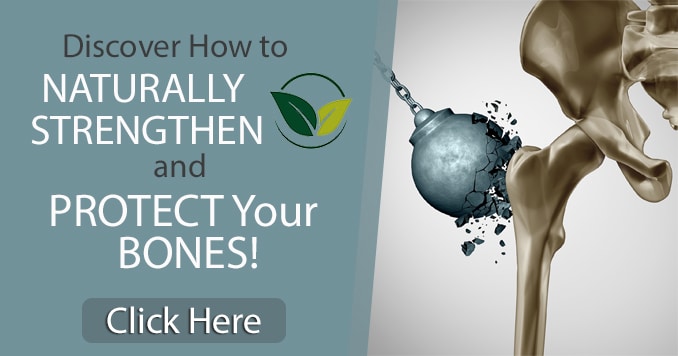Osteoporosis affects over 10 million Americans—mostly women over 50, especially after menopause. But it’s not just a women’s issue—men make up about 20% of cases too. [1]
This “silent disease” weakens bones gradually, often without symptoms until a fracture occurs. Simple movements like bending, lifting, or a minor fall can lead to serious breaks—especially in the spine, hips, and wrists.
Exercise is one of the best ways to protect your bones and stay independent as you age. But here’s the catch: not all exercises are safe if you have low bone density. In fact, some common moves can actually raise your risk of fractures.
Not all exercises are safe—some common moves could actually put your bones in danger. In this post, we’ll uncover the exercises that should be avoided if you have osteoporosis [2]—and share safer, bone-friendly alternatives to keep you strong, active, and protected.
12 Osteoporosis Prevention Exercises
1. Stability Ball Wall Squats
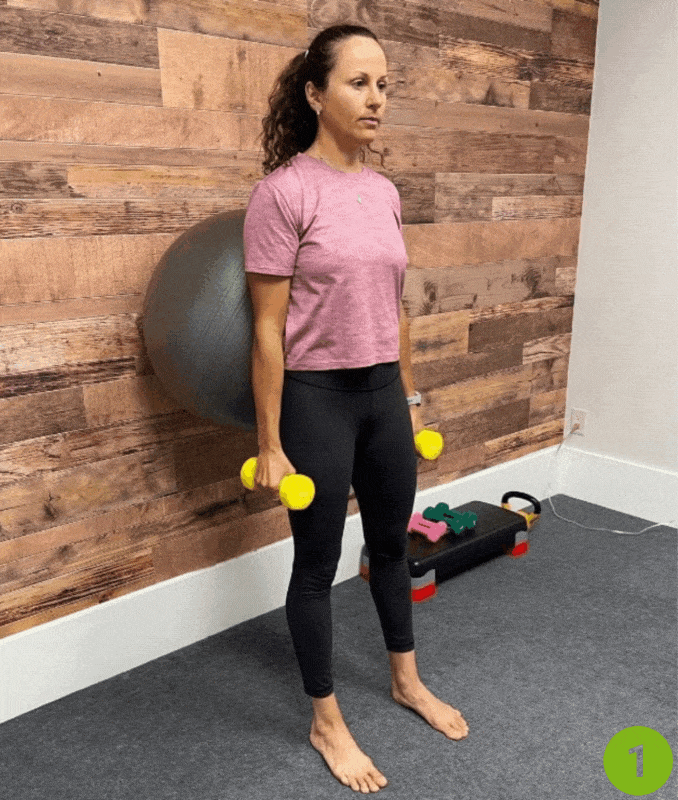
A stability ball helps to decrease friction between your body and the wall.
- Begin in an upright standing position with your feet shoulder-width apart.
- Place the stability ball between your body and the wall and step forward with both feet.
- Hold a dumbbell in each hand.
- Press your back into the ball as you bend your knees to lower your body to a sitting position.
- Push from your heels and straighten your legs to raise back up to a standing position, completing the squat movement.
- Repeat the movement.
- Perform 1 set of 10 repetitions.
2. Overhead Lift & Twist with Calf Raises
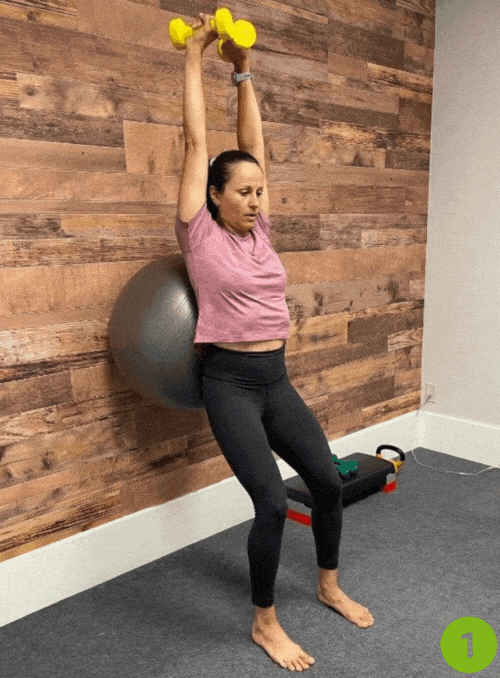
This exercise can challenge your brain as well as your muscles.
- Begin in an upright standing position with your feet shoulder-width apart and the ball pressed between your upper body and the wall.
- Hold a dumbbell in each hand and slightly bend your knees.
- Raise your arms overhead and slowly rotate your wrists back and forth as you raise to your toes on both feet.
- Lower your heels to the floor and repeat the movement, simultaneously rotating your wrists as you lift and lower your heels.
- Perform 1 set of 10 repetitions.
3. Semi-Squat with Regular Grip Shoulder Press
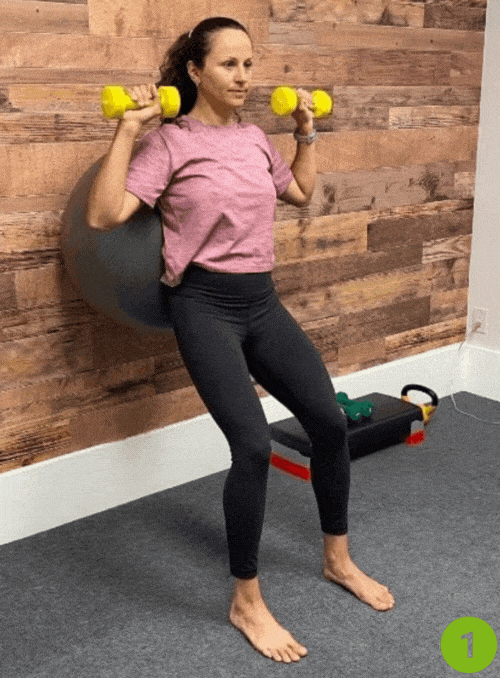
- Begin in an upright standing position with your feet shoulder-width apart and the ball pressed between your upper body and the wall.
- Bend your knees to lower your seat into a semi-squat position.
- Hold a dumbbell in each hand at shoulder-height.
- Press your arms overhead, then lower your arms to bring your elbows to shoulder-height.
- Repeat the movement, staying in the semi-squat position.
- Perform 1 set of 10 repetitions.
4. Semi-Squat with Narrow Grip Shoulder Press
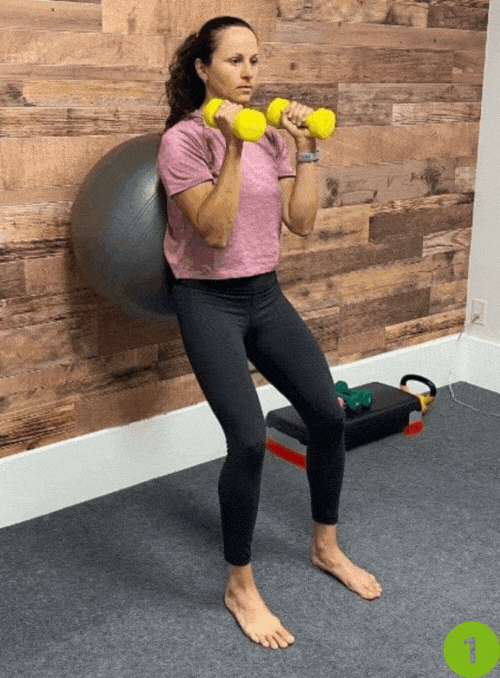
- Begin in an upright standing position with your feet shoulder-width apart and the ball pressed between your upper body and the wall.
- Bend your knees to lower your seat into a semi-squat position.
- Hold a dumbbell in each hand at shoulder-height in front of your body.
- Press your arms overhead, then lower your arms to bring your elbows to shoulder-height.
- Repeat the movement, staying in the semi-squat position.
- Perform 1 set of 10 repetitions.
5. Squat to Single Leg Raise
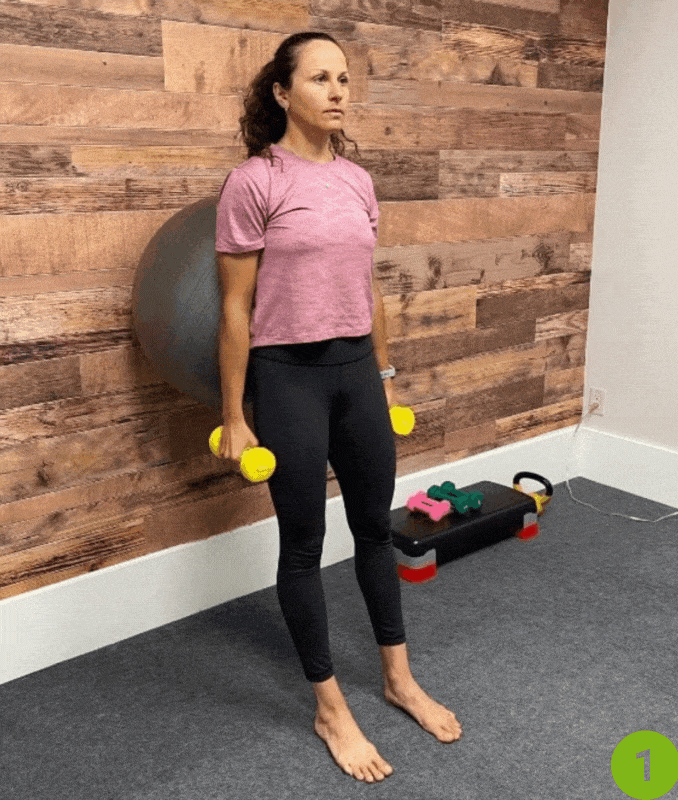
- For this exercise, place a hand on the back of a chair for extra support if needed.
- Begin in an upright standing position with your feet shoulder-width apart.
- Place the stability ball between your body and the wall and step forward with both feet.
- Hold a dumbbell in each hand at shoulder-height.
- If you are using the chair for support, hold one weight at your opposite shoulder.
- Press your back into the ball as you bend your knees to lower your body to a sitting position.
- Lift one foot, then push from your supporting heel to raise back up to a standing position.
- Repeat the sequence of movements.
- Perform 1 set of 5 repetitions on each side.
6. Bicep Curls with Calf Raises
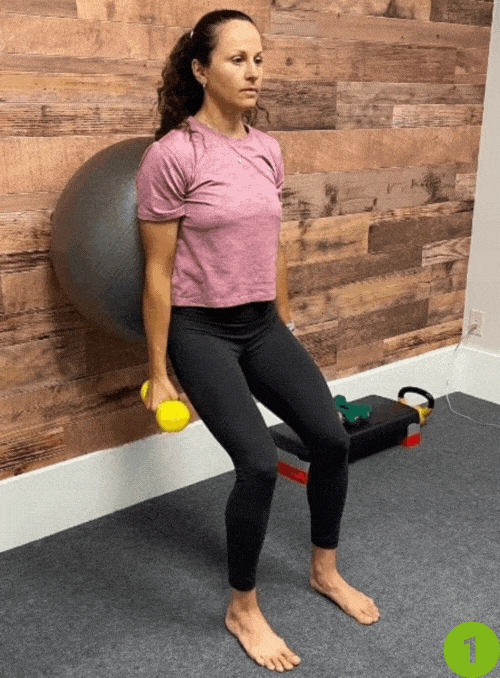
- Begin in an upright standing position with your feet shoulder-width apart and the ball pressed between your upper body and the wall. Hold a dumbbell in each hand and slightly bend your knees.
- Bend your arms to bring your hands to shoulder-height as you raise to your toes on both feet.
- Lower your hands to the starting position as you lower your heels to the ground.
- Repeat the movement.
- Perform 1 set of 10 repetitions.
7. Semi-Squat with Tricep Extension

- Begin in an upright standing position with your feet shoulder-width apart and the ball pressed between your upper body and the wall.
- Bend your knees to lower your seat into a semi-squat position.
- Hold a dumbbell in one hand and raise your arm overhead.
- Bend your arm to lower the weight behind your head, then straighten your arm to raise your arm overhead, completing the tricep extension.
- Repeat the movement, maintaining the semi-squat position.
- To intensify this exercise, perform alternating heel raises throughout the exercise.
- Perform 1 set of 10 repetitions on each side.
8. Supported Rows
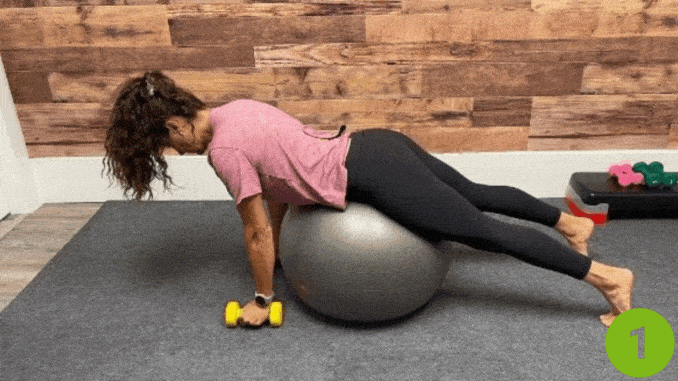
- Move into either a straight-arm plank position or a 4-point position with the ball under your body.
- Place one hand on the ground and hold a dumbbell in your other hand.
- Pull with your elbow in a rowing motion to bring the weight to chest-height, keeping your upper arm close to your body.
- Lower your arm to the starting position and repeat the movement.
- Perform 1 set of 10 repetitions on each side.
9. Supported Tricep Kickbacks

- Move into either a straight-arm plank position or a 4-point position with the ball under your body.
- Place one hand on the ground and hold a dumbbell in your other hand.
- Raise the weight slightly to align your upper arm with your body, then straighten your arm to bring the dumbbell just past your body.
- Bend your arm to return to the starting position and repeat the movement.
- Perform 1 set of 10 repetitions on each side.
10. Supported Chest Openers

- Move into either a straight-arm plank position or a 4-point position with the ball under your body.
- Place one hand on the ground and hold a dumbbell in your other hand.
- Slowly raise the weight up at your side, keeping your arm straight and following the movement with your gaze.
- Open up your chest at the top position.
- Lower your arm to the starting position and repeat the movement.
- Perform 1 set of 10 repetitions on each side.
11. Supported Flies
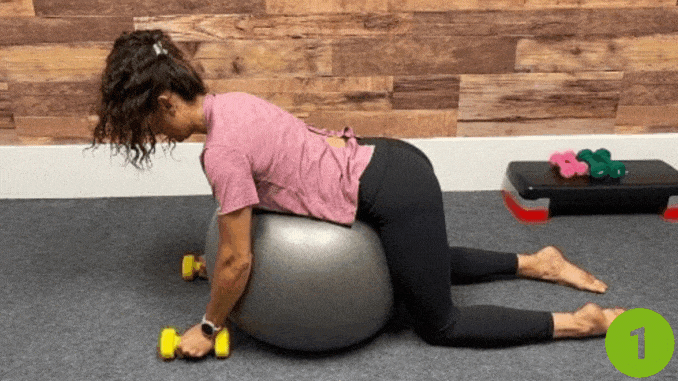
- If you find it too challenging to maintain your balance with this exercise, try pressing both feet into the wall.
- Move into either a straight-arm plank position or a 4-point position with the ball under your body.
- Hold a dumbbell in each hand.
- Engage your core and lift both arms out at your sides, keeping a slight bend in your elbows.
- Lower your arms back down to the starting position and repeat the movement.
- Perform 1 set of 10 repetitions.
12. Supported Lunge with Overhead Weight

- Begin in an upright standing position beside the wall, with the ball pressed between your upper body and the wall.
- Hold a dumbbell in your outer hand and rest your inner arm on top of the ball.
- Lift the weight overhead and hold the dumbbell in this position.
- Take a big step back with one leg, then bend your knees to lower your back knee downward.
- Straighten your legs to raise back up, then bend your knees to lower once again into the lunge movement.
- Repeat this movement, keeping your arm elevated overhead.
Exercises to Avoid with Osteoporosis
1. High-Impact Activities
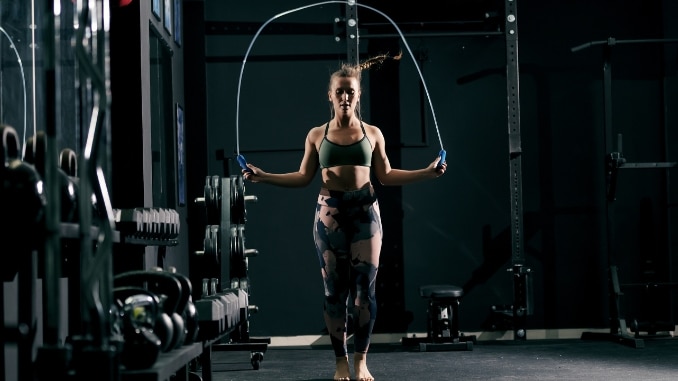
This is one of the exercises that should be avoided by individuals with osteoporosis. These can jolt fragile bones and increase the risk of fractures.
- Running or jogging on hard surfaces
- Jumping (jump rope, box jumps, high-impact aerobics)
- Contact sports (soccer, basketball, football)
2. Forward-Bending Movements (Spinal Flexion)
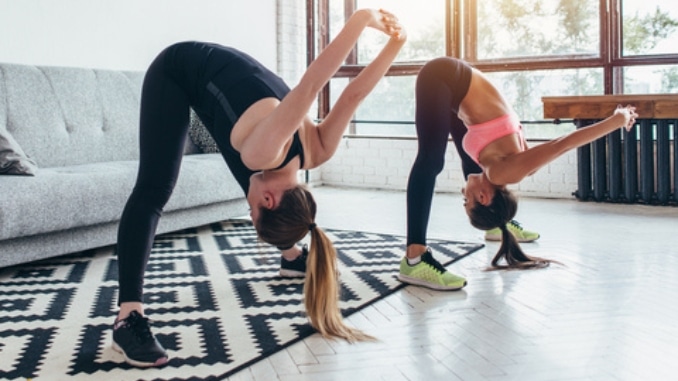
Bending the spine forward puts pressure on the vertebrae, increasing fracture risk.
- Toe touches
- Sit-ups or crunches
- Deep forward bends in yoga or Pilates
3. Twisting or Rotational Movements
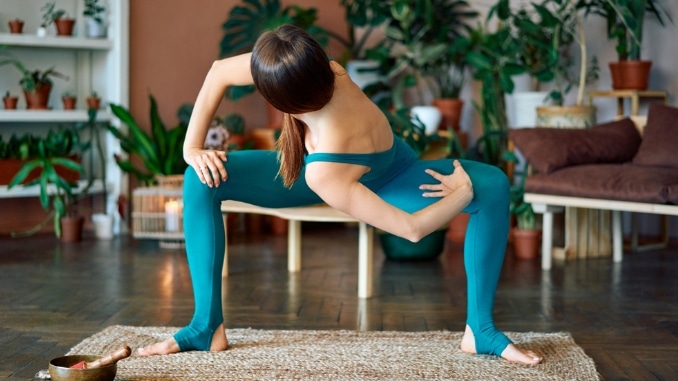
This exercises should also be avoided if you have osteoporosis. Can stress the spine and lead to fractures, especially if done forcefully or with weights.
- Golf swings
- Tennis strokes
- Twisting yoga poses (like revolved triangle or seated spinal twist)
4. Heavy Overhead Lifting

Puts compression on the spine and increases fall risk if balance is lost.
- Barbell shoulder presses
- Heavy squats with barbells
- Overhead kettlebell or dumbbell moves
5. Exercises that Increase Fall Risk

This another exercises that should be avoided if you have osteoporosis. Activities that challenge balance too much can lead to dangerous falls.
- Step aerobics on high platforms
- Hiking on uneven terrain without support
- Ice skating, skiing, or activities with slippery surfaces
How does Exercise Improve Bone Health?
Yes—exercise makes your bones stronger!
- Walking, dancing, and climbing stairs help build bone strength.
- Lifting weights or using bands makes bones and muscles stronger.
Studies show that regular movement:
- Increases bone strength
- Lowers the risk of weak bones and fractures
- Improves balance so you’re less likely to fall
Just remember: move with good form and control to stay safe.
How Much Exercise Do You Need for Healthy Bones?
To keep your bones strong and healthy, aim for:
- 30 minutes of weight-bearing exercise (like walking, jogging, dancing, or stair climbing) at least 5 days a week
- Strength training exercises (like squats, lunges, or resistance bands) 2 to 3 times a week
- Balance and flexibility moves (like yoga or tai chi) at least 2 times a week to help prevent falls
Conclusion
Dr. Meryl LeBoff, Director of the Osteoporosis Center at Brigham and Women’s Hospital, recommends combining medication with lifestyle changes to reduce fracture risk. That includes getting enough calcium and vitamin D, avoiding smoking and excess alcohol, and doing weight-bearing exercises like walking to help strengthen bones safely.
Focus on preventing [3] new fractures in people who’ve already had one. If you have osteoporosis, staying active is key—but choose exercises carefully. Avoid high-impact, bending, or twisting moves.
Instead, try walking, light strength training, and balance work. These safer options protect your bones and help you stay strong. Always talk to your doctor before starting a new routine.
Protecting your bones is vital to your safety. Learn how to naturally strengthen your bones. Check out this 14-Day Bone Strengthening Quick Start Program now!
Frequently Asked Questions
How should you sit with osteoporosis?
People with osteoporosis should sit using proper body mechanics to protect the lower spine. Avoid bending forward or slouching, which can involve spinal flexion and increase the risk of a spinal fracture. Sit upright with support, keep feet flat, and engage abdominal muscles gently. A physical therapist can show safe posture techniques for daily life.
Is too much walking bad for osteoporosis?
No—walking is one of the best weight bearing aerobic exercises to support bone health and slow bone loss. However, it should be part of a well-rounded exercise program. For people with osteoporosis, balance is key—don’t overdo it, especially if body weight strain leads to pain. Always combine walking with balance exercises and strength work using your own body weight or free weights as appropriate.
What exercises should be avoided if I have osteoporosis?
Exercises should be avoided with osteoporosis if they increase your risk of a broken bone, especially those involving twisting, jerking, or bending forward. Activities that strain the spine or involve quick, forceful motion (like sit-ups or heavy overhead lifting) can put you at high risk for fractures. Speak with a doctor or physical therapist to customize a routine that fits your body’s needs and avoids exercises that may cause harm.


